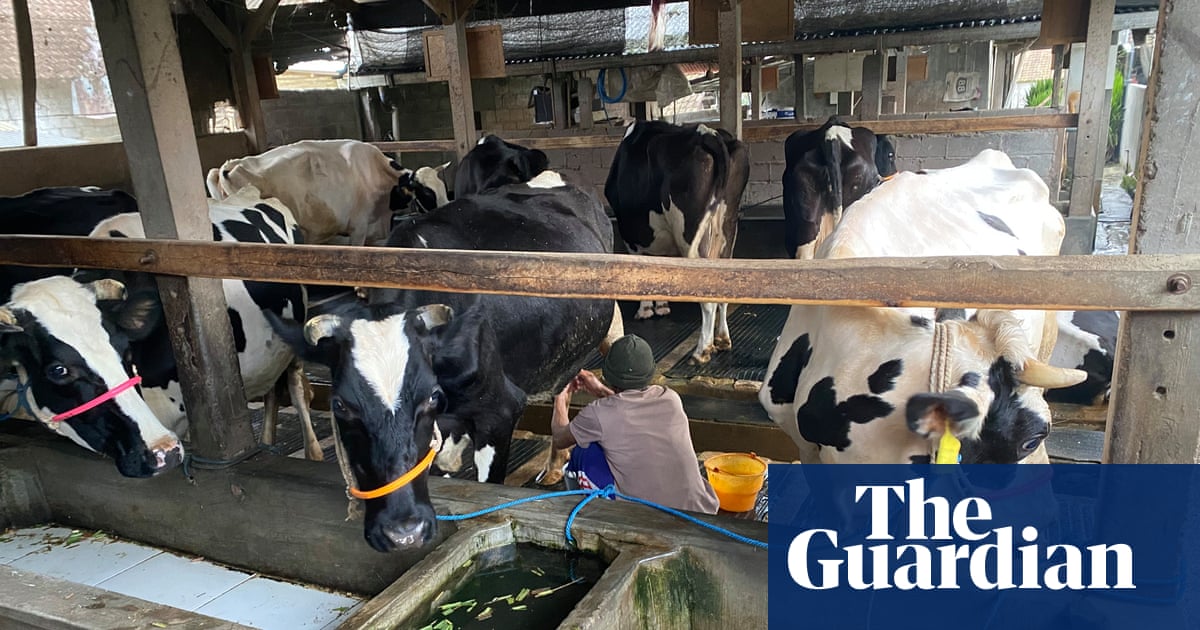
Show caption Indonesia is struggling to contain an outbreak of foot and mouth disease and has recorded more than 400,000 cases. Officials have announced they are aiming to get FMD under control by the end of the year Photograph: Peter Windsor foot-and-mouth disease Foot-and-mouth disease: how Indonesia is trying to control the outbreak by the end of the year Threat of FMD is biggest for Indonesia’s smallholder farms where families’ entire livelihoods are at stake and access to vaccine can be a problem Jordyn Beazley Thu 4 Aug 2022 03.18 BST Share on Facebook
Share on Twitter
Share via Email
Since the first case foot-and-mouth disease was reported in Indonesia at the start of May, it has spread like wildfire with almost 459,000 cases detected as of 4 August.
Indonesia has struggled to control the disease, estimated to cause an annual loss of US$1.37bn to Indonesia’s economy, with experts saying efforts to stem the spread have been hampered by a lack of vaccines and the fragmented nature of Indonesia’s livestock industry.
But government officials have announced Indonesia is aiming to get the outbreak under control by the end of this year. Here is what you need to know.
Show more
Where has foot-and-mouth disease been detected in Indonesia?
The first foot-and-mouth disease (FMD) case, since Indonesia was declared FMD-free in 1986, was reported in East Java in May. As of 4 August 2022 it has spread to 23 of Indonesia’s 37 provinces, including Bali, a hotspot for Australian tourists.
The disease has mainly been detected in cattle and among the smallholder farms that form 90% of Indonesia’s cattle industry. Prof Peter Windsor, an expert in livestock health at the University of Sydney, describes smallholder farms as mostly “dairy farms in back yards”. According to a 2018 study on the cattle industry in Indonesia, there are 6.5 million farmers in rural areas and 16.6 million cattle.
Ferdinandus Rondong, head of portfolio at Prisma, an organisation in Indonesia that supports smallholder farmers, said the rate of FMD infections had continued to drop since the beginning of July.
But Windsor said: “They say about half a million animals infected but you can probably put another zero on the end of that because we know the levels of reporting are always low.”
What is Indonesia doing to stem the spread of FMD?
The Indonesian government launched a nationwide rollout of vaccinations in mid-June. It has also restricted the movement of livestock with the help of police and the army, launched a campaign to educate farmers on the risks of FMD, and a number of infected livestock have been slaughtered.
As of 4 August just over 992,000 livestock have been vaccinated, 7,702 animals have been slaughtered and 4,847 have died.
On 19 July, a spokesperson for Indonesia’s FMD taskforce, Prof Wiku Adisasmito, told an online press conference that vaccination efforts were being hampered by a lack of supply and people to administer vaccines, as well as difficulties getting to farmers and keeping the vaccine at the correct temperature.
But in a recent briefing, Adisasmito said Indonesia is forging ahead with vaccinations and aims to get the outbreak under control by the end of the year.
“We hope by the end of this year, we can control the situation by having the number of cases reported reduced from time to time,” he said. “We would also reassure the international community that Indonesia is capable of controlling the outbreak.”
According to the Red Cross, the government has stated 30 million vaccines are needed. But so far only 3m vaccines have been secured, with an additional 1m expected to arrive in Indonesia from Australia soon. The Indonesian government is planning to produce vaccines locally, with production expected to start by the end of August.
Rondong said controls restricting the movement of cattle between islands had been weak, with the spread likely exacerbated by Idul Adha, a major Islamic holiday on 10 July which involves the sacrifice of animals and sharing the meat with the poor.
What is Australia doing?
Enhanced biosecurity controls have been put in place at Indonesia’s borders with a particular focus on Bali, according to a spokesperson for Australia’s department of agriculture. The controls include disinfectant foot mats for departing passengers and awareness raising materials.
Both the Australian and New Zealand governments have ramped up biosecurity controls domestically, including strict screening of inbound mail and freight from Indonesia.
The Australian government has committed A$5m (US$3.46m) to support Indonesia’s response, as well as mitigation measures in Timor-Leste and Papua New Guinea where the disease has not yet been detected. The money will fund testing, personnel and logistics support for the distribution of vaccine.
Are farmers being compensated?
The government is preparing a compensation scheme for affected farmers, with Rp10,000,000 (about A$960) for each forced slaughter. But a spokesperson for the Red Cross said there were concerns this was not enough for farmers to recoup their loss, with cattle often as valuable as farmers’ houses.
Windsor said that unlike the FMD outbreak in the United Kingdom, where livestock were culled to get the disease under control, forced slaughter is difficult in south-east Asian countries given livestock are the “bank accounts for smallholder farmers”, and also a crucial source of nutrition for rural Indonesian children.
In mid-July, Windsor visited two farms in Indonesia where animals had been infected with FMD. In one farm of 18 cows, milk production had dropped from an average of 250 litres a day to 15 litres.
“It has a massive impact on productivity for the farms,” he said. “And they are very concerned for the animals suffering from the disease.”








